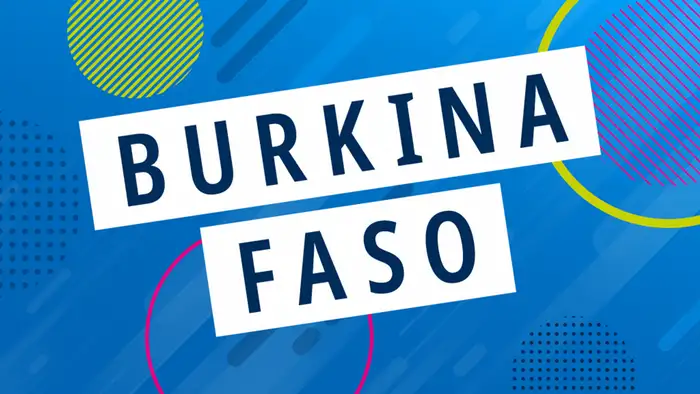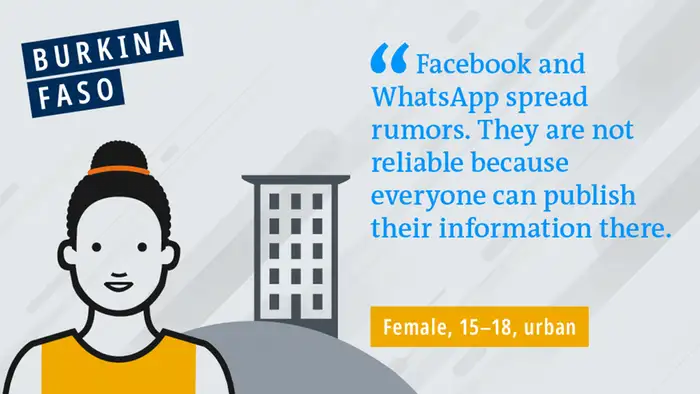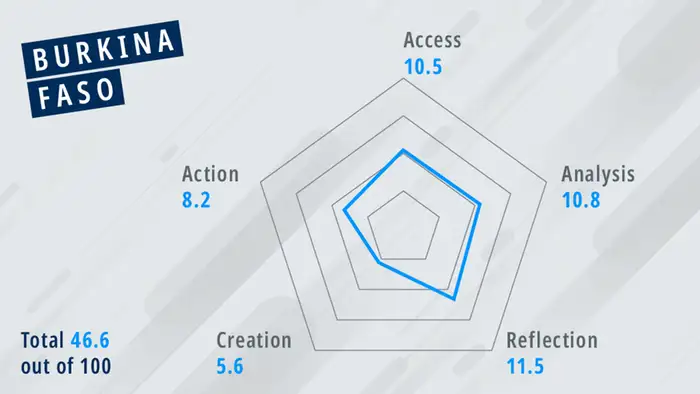MIL INDEX
Critical but disconnected: Media and Information Literacy amongst Burkina Faso’s youth
Burkina Faso’s youth are wary of hate speech and disinformation, but have limited digital access and lack opportunities to voice their concerns.
Reliable, high quality information is a key priority for the young generation in Burkina Faso. Perhaps as a consequence of political insecurities and the prevalence of violent extremism, a majority of young people between 15 and 25 years seems very aware of the negative consequences of malevolent forms of communication such as cyberbullying, disinformation and hate speech.
At the same time, many young people lack vital Media and Information Literacy skills in the fields of access, creation and analysis of media content. This is according to results from a 2019 representative survey conducted for the MIL INDEX study on behalf of DW Akademie.
Cyrille Guel from media NGO EducommunicAfrik echoes these findings, saying in an interview for the study that a basic knowledge of “how media work and how information is disseminated” is lacking. Denis Vincenti of development agency Fondation Hirondelle argues that this lack of skills emanates from the fact that young people are not given a chance to voice their concerns in the country, despite below 25-year-olds accounting for roughly 65 % of the population.
The country report summarized here is based on the findings of the MIL INDEX study, for which a representative survey, eight focus groups and six expert interviews were conducted in Burkina Faso between November 2018 and April 2019. The Study focused on five Media and Information Literacy (MIL) skill sets: Access, analysis, reflection, creation and action.
The average 15-25-year-old Burkinabè respondent had moderate to good skills when it came to access (10.5), analysis (10.8), as well as reflection (11.5). Deficits were found mainly in the areas of action (8.2) and creation (5.6). The total score amounted to 46.6 out of a possible 100.
Access
Taking a closer look at the different dimensions, young Burkinabè access radio and television regularly, and to a significantly lesser extent online. Whereas television is predominant in urban areas, radio access is highest in rural contexts though radio is the most important news medium in both urban and rural settings. A smartphone which is the most common device for Burkina Faso’s youth to access online media is owned by about two thirds of urban respondents and only one third of rural respondents. WhatsApp is used by almost every fifth and Facebook by roughly every third respondent on a weekly basis.
Both Internet access and smartphone ownership are substantially more common in urban than rural contexts and slightly more likely for male than female respondents. Access to print media is very low in urban and nearly non-existent in rural areas. Generally, the urban-rural divide is very pronounced in the field of access and economic, infrastructural and cultural difference play an important role.
Taking into account the diversity of media used on a weekly basis and the diversity of media used for news and information, the MIL INDEX score is moderate (10.5 out of 20).
Analysis
The young Burkinabè respondents show a good level of media knowledge. Over 70 % of respondents can define journalism and know about their right to freedom of expression. Roughly half of the young people can distinguish between Facebook and the Internet. Overall, these results add up to a moderate to good MIL INDEX score for analytical skills (10.8 out of 20).
Focus groups reveal that the young people possess some basic knowledge about the media landscape in Burkina Faso and have their own criteria regarding trustworthiness of information. The survey also showed that they are quite critical of the media landscape, though Reporters Without Borders has termed Burkina Faso “one of Africa’s success stories” with “dynamic, professional and diverse media” (Reporters Without Borders 2019). Local experts see room for improvement when it comes to questioning the information provided by opinion leaders or thinking about the ways in which information is disseminated.
Reflection
Over two thirds of respondents condemned disinformation, cyberbullying and hate speech which shows a strong awareness of adverse forms of communication. Perception of news bias and censorship however seems less pronounced among young Burkinabè, as only roughly 40 % of respondents were able to recognize these media problems. The overall MIL INDEX score for reflective skills is moderate to good (11.5 out of 20).
Focus groups confirmed that the young generation of Burkina Faso is frequently confronted with cyberbullying and disinformation. The most mentioned form of cyberbullying is sexual
harassment. Disinformation on the other hand is condemned because of the young peoples’ need for reliable information with regards to the present state of insecurity in the country.
Although mistrust in politicians and the political sphere is high, as confirmed by the study commissioned by Fondation Hirondelle in 2019, focus group and survey results of the MIL INDEX indicate a relatively low sensitivity for political bias and censorship among young Burkinabè. One reason might be the disenchantment with official politics, prompting young people to take political interference in media reporting for granted.
Creation
Young Burkinabè possess very basic skills in the field of creation. About 60 % of respondents reported using the basic skill of taking photos, less than half made audio recordings and about a third of respondents recorded videos or uploaded files at least sometimes. Updating their social media profiles, writing and publishing reports as well as creating blogs or WhatsApp groups was reported by even less young people. This resulted in a very weak MIL INDEX score (5.6 out of 20).
It seems the political uprising that took place in Burkina Faso in 2014 sparked a new quality of activity in terms of sharing photos, videos and information via social media (see Hagberg et al 2018: 21). But this activity on social media took place mainly in the urban center of the country. The focus groups also revealed that urban youths’ creation (and especially online) skills were generally more developed than the skills of young people from the countryside. Not being able to afford digital devices and lacking digital infrastructure proved to be significant obstacles.
Action
Action entails putting one’s MIL skills into practice for the good of society or for one’s own benefit. Respondents show limited skills when it comes to utilizing their media skills for the benefit of society: About 40 per cent share information with others, a third of respondents comments on issues in public at least sometimes, and every sixth young person reports having taken part in a campaign for freedom of expression or access to information. Urban respondents were more active throughout, perhaps because of better Internet access and closer proximity to the national goings-on in the political sphere.
The respondents’ MIL self-assessment is comparatively critical. Slightly more than half of the respondents are convinced that they can use media responsibly, analyze them critically and reflect their own use of media. The proportion of respondents believing they are good at creating and publishing their own content is considerably lower, at around 30 %. The MIL INDEX score for the sub-dimension of action is fairly weak (8.2 out of 20).
The picture transmitted by the focus group result is slightly different in terms of contributing to the good of society. Although national politics are regarded in a sceptical light, many participants mention examples of using social media for political actions. Several experts interviewed for the study echo the findings of Ouoba (2016) that young Burkinabè have gained confidence in using social media for political activism having assumed a major role in the dissemination of information during the mass protest against the former president in 2014.
It is worth noting that social exclusion of marginalized youth may be seen as one of the main drivers of violent extremism in Burkina Faso (see Loada and Ramoniuk 2014), emphasizing the need for inclusion of youth in national debates and issues. The media can be one vehicle for this to happen.
Conclusion
The MIL INDEX study focused on the Media and Information Literacy skills of 15-25-year-old Burkinabè. Based on the quantitative results, on average this age group has moderate skills
when it comes to access, analysis and reflection. Deficits were found mainly in the dimensions of creation and action. The MIL INDEX score was 46.6 out of a possible 100, meaning young people from Burkina Faso achieved lower mid-range results for Media and Information Literacy.
Methodological background
For each of the five dimensions (access, analysis, reflection, creation, action), survey respondents received a score ranging between 0 (= no skills whatsoever) and 20 (= highest level of skills) points. The scoring system measures how often certain skills are actually put into practice (access, creation, action) or tests the skills directly (analysis, reflection). Since citizens cannot permanently use media and information sources unless they are journalists or media workers, a perfect score of 100 for any country appears unrealistic—it is more about the relative performance across time, and in comparison to other countries, as well as being a tool for identifying deficits to be addressed in media development.
DW recommends
Downloads
- Date 22.10.2020
- Feedback: Send us your feedback.
- Print Print this page
- Permalink https://p.dw.com/p/3jv4y
- Date 22.10.2020
- Send us your feedback.
- Print Print this page
- Permalink https://p.dw.com/p/3jv4y



